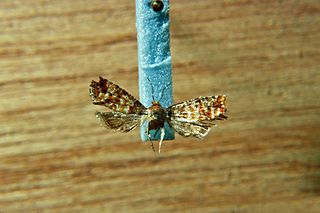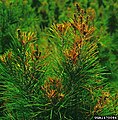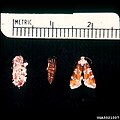
The Tortricidae are a family of moths, commonly known as tortrix moths or leafroller moths, in the order Lepidoptera. This large family has over 11,000 species described, and is the sole member of the superfamily Tortricoidea, although the genus Heliocosma is sometimes placed within this superfamily. Many of these are economically important pests. Olethreutidae is a junior synonym. The typical resting posture is with the wings folded back, producing a rather rounded profile.

Rhyacionia buoliana, the pine shoot moth, is a moth of the family Tortricidae. It is native to North Africa, North Asia, and Europe, and invasive in North America and South America.
Paraolinx is a genus of hymenopteran insects of the family Eulophidae.

Rhyacionia is a genus of moths belonging to the subfamily Olethreutinae of the family Tortricidae.

Rhyacionia duplana, the summer shoot moth or Elgin shoot moth when referring to subspecies logaea, is a moth of the family Tortricidae. It is found from northern and central Europe to eastern Russia, China and Japan. It has also been reported from Korea, but it has not been found in recent studies.

Rhyacionia pinicolana is a moth of the family Tortricidae. It is found from northern and central Europe to eastern Russia, China, Japan and Korea.

Rhyacionia pinivorana, the spotted shoot moth, is a moth of the family Tortricidae. It is found from northern and central Europe to eastern Russia, China, Korea and Japan.

Zeiraphera ratzeburgiana, the spruce bud moth or Ratzeburg tortricid, is a moth of the family Tortricidae. It is found from northern and central Europe to eastern Russia and China. Zeiraphera ratzeburgiana is a taxonomically similar species to Zeiraphera canadensis and can only be distinguished by an anal comb found in Z. canadensis.

Rhyacionia adana, the Adana tip moth, is a moth of the family Tortricidae. It is found in north-eastern North America, including Massachusetts, Pennsylvania, Virginia, Michigan, Wisconsin and Ontario.

Eucopina tocullionana, the white pine cone borer, is a moth of the family Tortricidae. It is found in North America from Minnesota to Quebec, south in the Appalachian Mountains to northern Georgia.

Rhyacionia bushnelli, the western pine tip moth, is a moth of the family Tortricidae. It is found in the United States, including Alabama, Nebraska, North Dakota and Montana.

Argyrotaenia pinatubana, the pine tube moth, is a species of moth of the family Tortricidae. It is found in eastern North America, from Canada south to Florida and west to Wisconsin.

Retinia arizonensis, the pinyon pitch nodule moth, is a species of moth of the family Tortricidae. It is found in North America.

Eucosma monitorana, the red pinecone borer moth, is a species of moth of the family Tortricidae. It is found in North America, including Pennsylvania, Ontario, Wisconsin and Maryland.

Rhyacionia subtropica, the subtropical pine tip moth, is a species of moth of the family Tortricidae. It is found in the United States in southern Alabama and Florida. It has also been recorded from Cuba and Belize.

Rhyacionia hafneri is a species of moth of the family Tortricidae. It is found in the Czech Republic, Hungary, Croatia, Bulgaria and Slovenia.
Rhyacionia dativa is a species of moth of the family Tortricidae. It is found in China, Taiwan, Korea, Japan and Russia.
Rhyacionia washiyai is a species of moth of the family Tortricidae. It is found in Japan on the island of Hokkaido.
Rhyacionia insulariana is a species of moth of the family Tortricidae. It is found in China.

Rhyacionia logaea, the Elgin shoot moth, is a species of moth belonging to the family Tortricidae, and used to be considered a subspecies of Rhyacionia duplana, the summer shoot moth, but is currently recognized as its own species. It has two similar sister species, which are Rhyacionia duplana duplana and Rhyciaonia duplana simulata. Its discovery is attributed to English entomologist John Hartley Durrant, F.E.S., who contributed his findings of the species R. logaea and R. duplana to the Trustees of the British Museum in 1911. The Elgin shoot moth is considered to be a micro-moth.



















